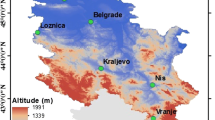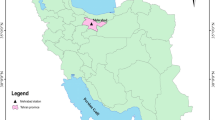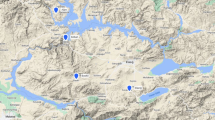Abstract
Evapotranspiration is a very important process of the water cycle. Thus, the ability to model and understand evolution of this process is very important for any field that is dealing with water management issues. This paper presents a model which is able to predict evapotranspiration value for one step ahead. The model includes external factors that have influence on evapotranspiration. Evapotranspiration is observed as a time series with monthly records for several years. The time series modeling is conducted by artificial neural network infrastructure. The model is composed of three neural networks with different type of features in the input layer. Two networks are feed-forward, and one is recurrent. The prediction model composed of the three artificial neural networks is able to predict evapotranspiration values quite close to the original ones. The right choice of features and network type made this model very useful. This paper introduces another aspect of using artificial neural network in order to increase the precision of predicting the evapotranspiration time series.





Similar content being viewed by others
References
Aghajanloo M-B, Sabziparvar A-A, Talaee PH (2013) Artificial neural network–genetic algorithm for estimation of crop evapotranspiration in a semi-arid region of iran. Neural Comput Applic 23 (5):1387–1393
Allen RG, Pereira LS, Raes D, Smith M, et al. (1998) Crop evapotranspiration-guidelines for computing crop water requirements. FAO Irrigation and Drainage Paper 56(9):1–15
Appelhans T, Mwangomo E, Hardy DR, Hemp A, Nauss T (2015) Evaluating machine learning approaches for the interpolation of monthly air temperature at mt. kilimanjaro, tanzania. Spatial Statistics 14:91–113
Astsatryan H, Grigoryan H, Poghosyan A, Abrahamyan R, Asmaryan S, Muradyan V, Tepanosyan G, Guigoz Y, Giuliani G (2021) Air temperature forecasting using artificial neural network for ararat valley. Earth Sci Inf 14(2):711–722
Aziz K, Rahman A, Fang G, Shrestha S (2014) Application of artificial neural networks in regional flood frequency analysis: a case study for australia. Stoch Env Res Risk Assess 28(3):541–554
Bishop CM (1995) Neural networks for pattern recognition. Oxford University Press, Oxford
Bishop CM (2006) Pattern recognition and machine learning. Springer, New York
Feng Y, Peng Y, Cui N, Gong D, Zhang K (2017) Modeling reference evapotranspiration using extreme learning machine and generalized regression neural network only with temperature data. Comput Electron Agric 136:71–78
Gadi V, Singh S, Singhariya M, Garg A (2018) Modeling soil-plant-water interaction: effects of canopy and root parameters on soil suction and stability of green infrastructure. Eng Comput 35(3):1543–1566
Gocić M, Shamshirband S, Razak Z, Petković D, Ch S, Trajković S (2016) Long-term precipitation analysis and estimation of precipitation concentration index using three support vector machine methods. Advances in Meteorology, 2016
Gocić M, Trajković S (2014) Analysis of trends in reference evapotranspiration data in a humid climate. Hydrol Sci J 59(1):165–180
Gocić M, Trajković S (2014) Drought characterisation based on water surplus variability index. Water Resour Manage 28(10):3179–3191
Granata F (2019) Evapotranspiration evaluation models based on machine learning algorithms - a comparative study. Agric Water Manag 217:303–315
Guo B, Chu F, Zhai Y, et al. (2018) Prediction of nox emission of a power plant boiler based on adaptive simplified ts model. Filomat 5:32
Hargreaves GL, Hargreaves GH, Riley JP (1985) Irrigation water requirements for Senegal river basin. J Irrig Drain Eng 111(3):265–275
Khoob AR (2008) Comparative study of hargreaves’s and artificial neural network’s methodologies in estimating reference evapotranspiration in a semiarid environment. Irrig Sci 26(3):253–259
Kim S, Kim HS (2008) Neural networks and genetic algorithm approach for nonlinear evaporation and evapotranspiration modeling. J Hydrol 351(3-4):299–317
Kisi O, Cimen M (2012) Precipitation forecasting by using wavelet-support vector machine conjunction model. Eng Appl Artif Intell 25(4):783–792
Kumar M, Bandyopadhyay A, Raghuwanshi N, Singh R (2008) Comparative study of conventional and artificial neural network-based eto estimation models. Irrig Sci 26(6):531
Kumar M, Raghuwanshi N, Singh R (2009) Development and validation of gann model for evapotranspiration estimation. J Hydrol Eng 14(2):131–140
Kumar M, Raghuwanshi N, Singh R (2011) Artificial neural networks approach in evapotranspiration modeling: a review. Irrig Sci 29(1):11–25
Landeras G, Ortiz-Barredo A, López J. J. (2008) Comparison of artificial neural network models and empirical and semi-empirical equations for daily reference evapotranspiration estimation in the basque country (northern spain). Agric Water Manag 95(5):553–565
Lau C (1991) Neural networks: theoretical foundations and analysis IEEE press
Lin L, Wang F, Xie X, Zhong S (2017) Random forests-based extreme learning machine ensemble for multi-regime time series prediction. Expert Syst Appl 83:164–176
Maguolo G, Nanni L, Ghidoni S (2021) Ensemble of convolutional neural networks trained with different activation functions. Expert Syst Appl 166:114048
Patil AP, Deka PC (2016) An extreme learning machine approach for modeling evapotranspiration using extrinsic inputs. Comput Electron Agric 121:385–392
Pereira OCN, Suguiura TPDS, Pereira AP, Bertonha A, Previdelli I (2019) Analysis of lettuce evapotranspiration across soil water, Natural Resource Modeling, 32(2). https://doi.org/10.1111/nrm.12197
Ray SN, Chattopadhyay S (2021) Analyzing surface air temperature and rainfall in univariate framework, quantifying uncertainty through shannon entropy and prediction through artificial neural network. Earth Sci Inf 14(1):485–503
Shiri J, Sadraddini AA, Nazemi AH, Kisi O, Landeras G, Fard AF, Marti P (2014) Generalizability of gene expression programming-based approaches for estimating daily reference evapotranspiration in coastal stations of iran. Journal of hydrology 508:1–11
Shrestha N, Shukla S (2015) Support vector machine based modeling of evapotranspiration using hydro-climatic variables in a sub-tropical environment. Agricultural and forest meteorology 200:172–184
Singh P, Borah B (2013) Indian summer monsoon rainfall prediction using artificial neural network. Stoch Env Res Risk Assess 27(7):1585–1599
Sudheer K, Gosain A, Mohana Rangan D, Saheb S (2002) Modelling evaporation using an artificial neural network algorithm. Hydrol Process 16(16):3189–3202
Torres AF, Walker WR, McKee M (2011) Forecasting daily potential evapotranspiration using machine learning and limited climatic data. Agric Water Manag 98(4):553–562
Trajković S, Kolaković S (2010) Comparison of simplified pan-based equations for estimating reference evapotranspiration. J Irrig Drain Eng 136(2):137–140
Traore S, Guven A (2012) Regional-specific numerical models of evapotranspiration using gene-expression programming interface in sahel. Water Resour Manage 26(15):4367–4380
Yildirak K, Kalaylıoglu Z, Mermer A (2015) Bayesian estimation of crop yield function: drought based wheat prediction model for tigem farms. Environ Ecol Stat 22(4):693–704
Yildirak K, Selcuk-Kestel AS (2015) Adjusting spi for crop specific agricultural drought. Environ Ecol Stat 22(4):681–691
Author information
Authors and Affiliations
Corresponding author
Additional information
Communicated by: H. Babaie
Publisher’s note
Springer Nature remains neutral with regard to jurisdictional claims in published maps and institutional affiliations.
Milan Gocić, Katarina Petković and Slaviša Trajković are contributed equally to this work.
Rights and permissions
Springer Nature or its licensor (e.g. a society or other partner) holds exclusive rights to this article under a publishing agreement with the author(s) or other rightsholder(s); author self-archiving of the accepted manuscript version of this article is solely governed by the terms of such publishing agreement and applicable law.
About this article
Cite this article
Popović, P., Gocić, M., Petković, K. et al. Neural network based system in evapotranspiration time series prediction. Earth Sci Inform 16, 919–928 (2023). https://doi.org/10.1007/s12145-023-00935-7
Received:
Accepted:
Published:
Issue Date:
DOI: https://doi.org/10.1007/s12145-023-00935-7




